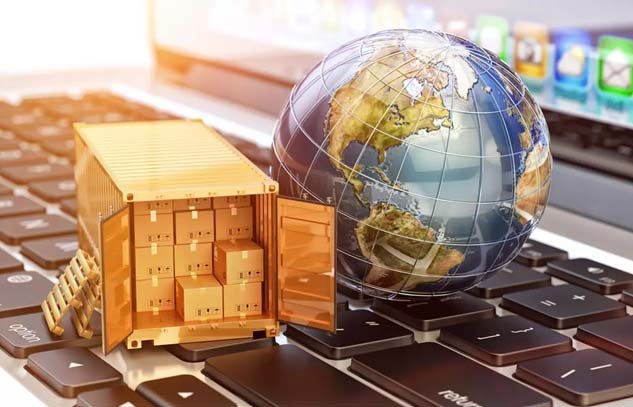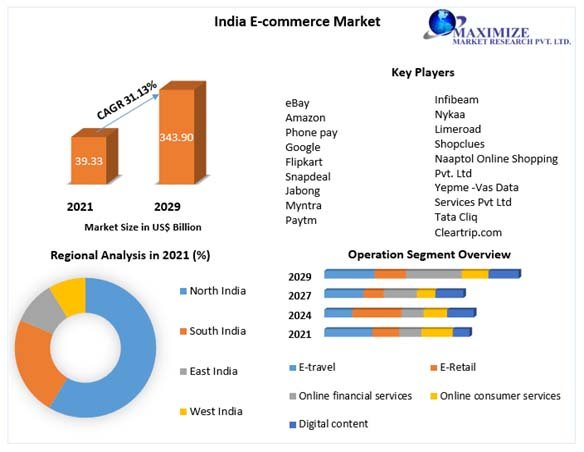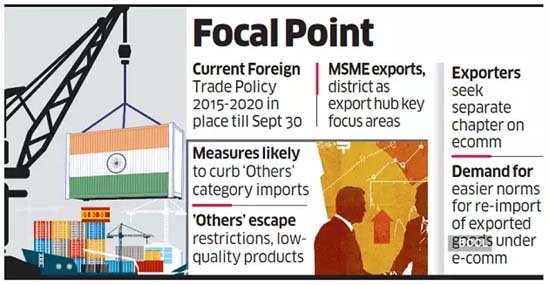INDIA’S E-COMMERCE EXPORTS

CONTEXT :
- India’s e-commerce exports have the potential to grow at a faster pace than IT exports in early 2000s.
ABOUT INDIA’S E-COMMERCE EXPORTS :

- India’s current e-commerce exports remain far below their potential.
- Currently, they account for only $2 billion, less than 0.5 per cent of India’s total goods export basket.
- The country must plan to export $350 billion, or about one-third of its total goods, through e-commerce by 2030.
INDIA’S STRENGTH IN E-COMMERCE EXPORT SECTOR :
- With global Business to Consumer (B2C) e-commerce exports estimated to grow from $800 billion to $8 trillion by 2030.
- India’s strength is in high-demand customised products.
- Constant expanding seller base.
- Higher profit margins per unit of export.
REASONS FOR SUCH LOW EXPORTS :
- Developing the ecosystem for e-commerce exports as India’s current e-commerce export provisions are a patchwork of rules framed for regular B2B exporters.
- This creates an enormous compliance burden on small firms, and India needs to address all such issues in one place.
- Shipping and delivery of products to foreign countries can be expensive and time-consuming, leading to dissatisfaction among customers.
- Lack of standardization in terms of product quality, delivery, and customer service.
- Same set of policy and regulations for e-commerce export as of normal exports of goods and services.
ACTION STEPS : WHAT NEEDS TO BE DONE?
- Various recommendations have been identified to increase e-commerce exports from India.
These cover four broad categories :
1. REDEFINE THE RESPONSIBILITIES OF SELLERS :
- Small and medium-sized firms rely on e-commerce platforms for global exposure and value-added services, such as timely payment assurance.
- However, this conflicts with FEMA regulations as the platform is responsible for receiving payment, while the ownership of goods remains with the seller.
2. SIMPLIFY PAYMENT RECONCILIATION :
- Payment reconciliation is a major roadblock for third-party e-commerce exporters.
- The RBI guidelines for B2B exports need changes to accommodate B2C exports.
The changes needed to simplify payment reconciliation are : - Sellers must receive forex within nine months of shipment, which is challenging for shipments sold over 12-18 months. More time is needed to reconcile payments.
- Lower restrictions on receipt of export proceeds: Forex received must not vary more than 25 per cent of the value stated in the export document. A 25 per cent reduction cap is too restrictive for ecommerce sales that involve discounts and returns.
- Ecommerce exports have a high number of small shipments and invoices per large shipment, which increases the payment reconciliation burden.
- Simplify foreign inventory management documentation: Documentation burden for forward deploy inventory to an overseas warehouse is cumbersome. Foreign inventory management documentation must be simplified.
- Online bank processes : Issuing Authorised Dealer (AD) code letters and submitting documents to banks are done offline. For ecommerce exports, banks don’t recognise the fund flow as an export transaction, causing a delay (around two weeks) in AD code letter generation.
3. SIMPLIFY EXPORT POLICY AND PROCESSS :

- Raise the value cap for ecommerce exports from ₹5 lakh to ₹25 lakh.
- As most trade is shifting to GVCs (global value chains) requiring timely deliveries, exporters must be allowed to choose the shipment mode as per their business requirements.
- Create separate customs codes for ecommerce shipments to avoid delays caused by ad hoc document requests by customs officials and allow green channel clearance for ecommerce shipments, similar to China’s customs supervision codes.
- Exempt import duties on rejects and treat reimports as duty-exempt imports in line with global practices to reduce costs and expedite the delivery of merchandise.
- Reduce the Courier Shipping Bill processing time from 34 hours to less than 20 minutes by making changes in the Express Cargo Clearance System (ECCS).
4. SET UP E-COMMERCE NATIONAL TRADE NETWORK :
- This network will bring together the RBI, Customs, DGFT, GSTN, India Post, courier companies, platforms like Amazon and eBay, and the user to create a central technology platform that streamlines the entire process.
WAY FORWARD :
- E-commerce will democratise export process by allowing lakhs of small firms to export.
- Exports will grow exponentially with removal of onerous regulatory compliances.
- The E-Commerce Export Policy should be an independent document addressing all pain points faced by exporters.
SOURCE : THE HINDU BUSINESS LINE
SYLLABUS : MAINS, GS-3, INDIAN ECONOMY


